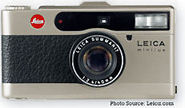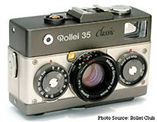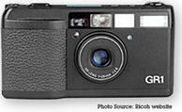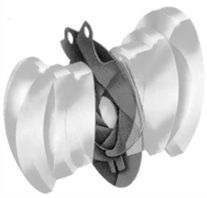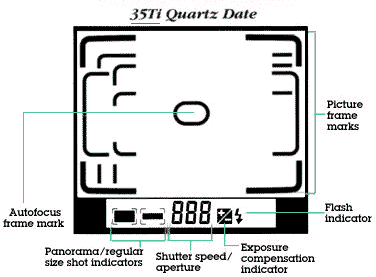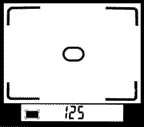 |
|
Further, there were quite a number
of competing camera manufacturers that have a few equally exciting options in the
similar class. Some of the more popularly known labels were the original Contax T2*(released back in 12.1990), Contax
T3* (03.1991); Rollei
Elite class; Leica Minilux-series and even relatively less aggressive
company such as Ricoh also has quite a very well-spec Ricoh
GR-1 to
offer to consumers for alternate considerations. So, this was not entirely a Nikon
territory. In fact,it was the Kyocera who has successfully created this market segment
with the debut of the Contax T2* back in 1990 and the Nikon 35Ti was
Nikon initial answer to the aggression Kyocera posted..
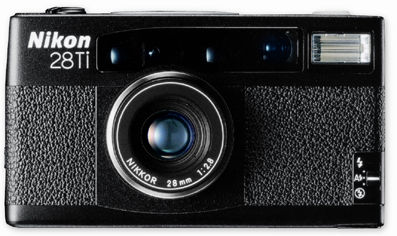 |
But true enough, within own family of Nikon compact models, both the elegantly look, bright chrome-finish Nikon 35Ti & the all-black chrome version of the Nikon 28 Ti can easily be regarded as the best Nikon compacts ever - as both models perform so much better than any other models you might compare them to - simply, it surpasses all others that came before it. Even if one uses them as a yardstick to compare with any other rivaling brands, with the many original innovations and delightful features embodied within, I don't think anyone would object the fact where the original effort Nikon has poured in for the realization of both these cameras can easily be appreciated by all compact camera enthusiasts worldwide. |
Individually, each of them
was a perfect camera to take anywhere as your primary camera, or added to an SLR
system as a convenient extra camera for quick, responsive photography. So, along
with the many compacts that I admire so much out there, I would easily rank these
two lovely bodies as another modern classic of my times:-
Main features & Technical highlights:-
(BEFORE proceed to other sections, select
a Nomenclature for either Nikon 35TiQD or the Nikon
28TiQD model as
visual reference.
|
* |
|
A superbly crafted Nikkor 35mm f/2.8 moderate wideangle lens. It was also the first Nikon compact that was supplied with a Nikkor-class optic. The 28Ti's Nikkor 28mm f/2.8 was equally commendable top class Nikkor optic. They are sharp, contrasty, with a centre-to-edge performance that rivals that of the finest lenses made for SLR cameras. |
|
* |
|
Nikon's proprietary lens coating process, Integrated optical coating (NIC) was applied throughout on all lens elements. Resulting images with superior contrast, clarity and colour rendition. |
|
* |
|
833-step Autofocus: more AF steps than any other active-infrared AF system in a compact camera. Manual preset focus is also possible. |
|
* |
|
Renown Nikon 6-segment 3D Matrix metering - the first of its type for dynamic exposure control. |
|
* |
|
Titanium body chassis. A metal with properties of exceptional strength and resistant to shock, impact and corrosion enables the camera stronger and lighter. |
|
* |
|
A unique, classic design in an analogue-type full information display system - another first in a compact. |
|
* |
|
Built-in speedlight for Fill-Flash |
|
* |
|
Exposure control modes in either Programmed AE, Flexible Program AE, Aperture Priority AE with exposure compensation control for exposure fine-tuning. |
|
* |
|
Quartz Date function built in, works in both standard and Panorama film formats. |
|
* |
|
Custom functions, a feature usually found in expensive SLR models, it permits setting up the 35Ti Quartz Date work according to individual preferences. |
Both of these Nikon compact bodies were designed to be last & appreciated for many years to come. Their external designs will appeal to esthetic sense of someone who will appreciate time-honoured classic: the solid, no-frills, classic look simply won't just go out of style. With its titanium exterior, both the 35Ti & 28Ti Quartz Date are light in weight yet strong to accidental impact as well as anti-corrosive. Inside this tough exterior are the lens barrel and focusing helicoid, both made from tough, precision aluminum alloy for reliable and repeatable focusing accuracy.
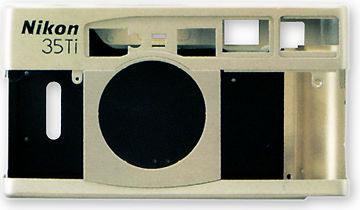 |
The aerospace-quality titanium metal casing covers the motors and the camera's state-of-the-art microelectronics including CPUs and ICs. The top deck of the two cameras incorporate an unique, very innovative but easy-to-view classic analogue display system, providing all the important camera settings & data with pointers and scales for quick and easy guide during picture taking. They are solid and provide a very comfortable feel. The Command Input Control dial was also a first in a Nikon - even ahead of the Nikon F5 by a few years. It lets you select aperture, override automation with a Flexible Program, decide distance in the Manual Focus Preset mode, as well as determine exposure compensation and other settings. The design was meant for spontaneous, automatic operation facilitates quick reaction in photography. |
| Note:- Stealth beneath the all black-chrome finish, the Nikon 28Ti also carries similar metal structure as the 35Ti shown above. | |
Both of the 35Ti & 28Ti was indeed a very serious effort by Nikon. Many of the high performance Nikon SLR-type features, built quality & optical performance were being transferred in the development of these two compacts. You get a choice of two very practical focal lengths of 28mm & 35mm with either of the two models for day to day use and/or for creative application photography as each of these lenses came with equally exceptional optical quality. If one prefers a more dynamic perspective in pictures for shooting landscapes, buildings or even tight interiors, the 28mm wideangle would be handy. On the other hand, the 35mm moderate view which coupled to the 35Ti QD model offers users with a damn good use of an traditional all-round-use optic. Both of these supreme class Nikkor lenses, 35mm f/2.8 with a six elements in four groups optical composition, while the Nikkor 28mm uses a seven elements in five groups design, enable close focusing down to a minimum distance at 0.4m - the closest among all the Nikon compacts. Lastly, the two Nikkor were also designed to provide a minimum aperture of f/22 - incredibly useful for creative depth of field control in landscapes, close-up photography as well as enabling the use of high speed film types for general photography.
 |
The two Nikkor wideangle lenses were employed with Nikon high refractive index low-dispersion glasses, assuring crisply sharp detail from centre to edge. Even the lens-shutter and diaphragm were specially designed for enhanced their respective optical performance. |
 |
Others:- This comprehensive optical system represents a major advance in camera design in a compact camera. The cameras optical axis perpendicularly to the film plane and maintenance of critical optical alignment are assured. While the lens barrel and focusing helicoid are boned from high-precision aluminum alloy for consistent focusing accuracy. Film guide rails are also using aluminum alloy for superior resistance to abrasive film wear. The cameras' film transport has a rather straight forward system as continuous focusing and raid film advance is not provided, so the emphasis was entirely on reliability. For an example, all the electrical contacts for the DX film coding were gold-plated for positive transmission of data. |
The sophisticated focusing system was equally impressive and was specifically designed to deliver exceptionally sharp focusing capability. With 833 AF steps (for practical purposes, this system is stepless and more precise than any previous active-infrared autofocus system found during that era), both the Nikon compacts can autofocus from 0.4m for detail-revealing close-ups all the way to infinity for razor-crisp landscapes. Even off-centre composition has been taken good care of with an additional focus lock feature (lightly depress the shutter release button will lock focus, keeping it depressed ad recompose the picture you desired and press the button fully to take the picture). With the active infrared autofocus which can he precisely aimed, either camera can even focus in almost total darkness to explore exciting picture-taking opportunities. You can even preset the focus distance manually, using the focus distance display on the top deck panel as visual reference.
 |
For those who may be interested (it becomes very critical when shooting close ups) with the estimated depth of field generates with respective aperture used, click on the table for an enlarged view. I have lost my Nikon 28Ti (@$#&$*!!) can't scanned one copy here for download. |
Actually, you need no have to worry too much how the autofocusing works. As long as you point the subject within the autofocus frame mark and pictures should come out sharp. However, Nikon was considerate enough as owners of these two cameras are mainly targeted at serious amateurs and thus, other than autofocus, both models were equipped with other options in focusing control. One of them is infinity focus. The first button on the vertical row of three located on the top panel with an "AF" mark is for that purpose. While depressing this button, turn the Command Dial so the distance indicator points to infinity symbol (
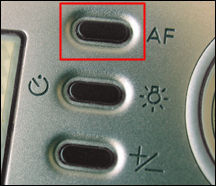 |
The aerospace-quality titanium metal casing covers the motors and the camera's state-of-the-art microelectronics including CPUs and ICs. The top deck of the two cameras incorporate an unique, very innovative but easy-to-view classic analogue display system, providing all the important camera settings & data with pointers and scales for quick and easy guide during picture taking. They are solid and provide a very comfortable feel. The Command Input Control dial was also a first in a Nikon - even ahead of the Nikon F5 by a few years. It lets you select aperture, override automation with a Flexible Program, decide distance in the Manual Focus Preset mode, as well as determine exposure compensation and other settings. The design was meant for spontaneous, automatic operation facilitates quick reaction in photography. |
At the time of their introduction, you can say both of the Nikon 35Ti & 28Ti Quartz models provide the most accurate metering guide for ambient exposure control. Nikon pioneered 3D Matrix Metering found on their top performing SLR was used because thought both the cameras deserve the best light meter in them - although many thought it was a marketing gimmick but nevertheless, it was a practical move and the performance proven metering system can deal with nuances of brightness & contrast, glare and shade or backlighting and more.. for the record, matrix meter was used for the first time in a compact camera.
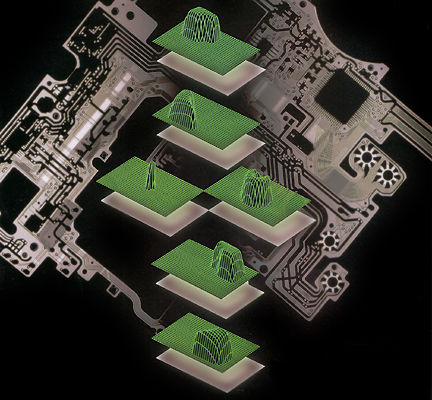 |
Nikon's 3D metering system used divides each scene into 6 areas analyzing them for brightness and contrast (that's the Matrix part) and evaluates the lighting information in relation to the focused camera-tto-subject distance (that's the 3D part). The camera's microcomputer will then analyze the data using fuzzy logic, based on a proprietary advanced algorithms, calculated & resulting with a theoretical optimum exposure settings set. |
The shutter release button cum Exposure Mode Selector on the top panel is a feather touch electromagnetic button. When lightly press, it will activates the metering and stay on for a period of time, turn off to conserve battery power. For exposure control, just slide the mode selector lever to the orange "P" will activate Programmed AE where it will set optimum exposure automatically. You can opt for alternate Aperture-Priority AE (green "A"), which lets you select the apertures from f/2.8 to f/22, while the camera sets the matching quartz timed shutter speed to deliver an exposure. Or you can also use Flexible Program to set a different combination of aperture and shutter speeds while keeping a correct exposure. The L.T on the selector dial stands for LONG TIME exposure, it doubles up as a B setting on SLR camera, except it operates slightly different. When you push the lever to "L.T", shutter remains open until the shutter release button is depressed for the second time. The time duration can even last up to 10 minutes. The film counter cum exposure time calculator (great huh ?) on the top analogue display will begin rotating from "o" position, and indicating the exposure time (it will stop at the L.T mark after 50 seconds to conserve power). Remember to depress the shutter release button once more to stop exposure after you have determined the duration is enough.
 |
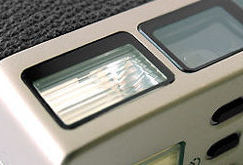 |
 |
 |
When conditions call for artificial illumination where flash is required, the camera built-in speedlight will respond automatically - that is - if you want it to. A flash symbol will light up when the ambient light is not sufficient to suggest a good exposure. If you operate flash in Aperture Priority AE, shutter speed can be controlled to as low as 1/4 sec. OR 1/30 sec in Programmed AE mode - great for balance-filled or slow sync flash photography to get a good balance between the illuminated subject & the background. The anytime flash feature is great for situations such as, for an example, fill-in shadow in a broad daylight scenario where you need the flash to ignite to soften harsh shadows for great portraits or to enhance outdoor close-ups with extra-sharp DOF deliveries with the use of small apertures (f/16 or f/22). The auto flash can also be canceled:- it was a little tricky to operate with the tiny button on the Nikon 35Ti model where you may not be totally sure if it has been canceled but Nikon patched this flaw with a more friendlier to operate (& more assuring) three switches on the Nikon 28Ti Quartz Date model later. Both 28Ti and 35Ti even incorporate a popular Red-Eye Reduction lamp for better flash pictures on portraits or group PR shots. Note: * you can also set your choice for Flash Cancel or Auto Flash through Custom Function control; as for flash, if the flash icon inside the finder blinks before you even take an exposure, it simply means battery is weak, wait for a few seconds, and take the picture.
 |
Flash shooting range Before shooting with flash, make sure the subject is within the flash shooting range for the film speed in use. The flash shooting distance varies as in the following table. Note that overexposure may occur if you take close-up pictures with film rated IS01 600 or higher. (Chart - 30k Gif) |
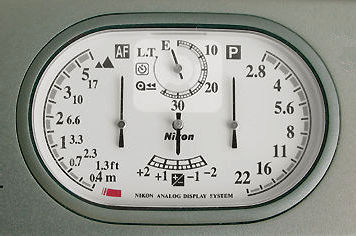 |
|
 |
When anyone tries to relate to any of these two Nikon compact models, one would easily remember its unique information display method as Nikon could have cut corners by deploying a much cheaper, popular LCD-type display rather than taking so much effort in designing such an innovative system. The Swiss-watch Chronometer type of display in the two cameras may be an eye-catching feature but it delivers the kind of quick and intuitive understanding which combined with a sense of practical range, positions as well as an artfully arrangements All the essentially data or information relate to picture taking was visible through this crystal clear analogue display panel which comprises of accurate and easy to read pointers/scales. You can see focus selection, aperture in use or exposure compensation values, as well as film count, time exposure and self-timer indication all at one glance. |
On a less evidence note, even the optical viewfinder system in both the camera packed with a lot of technologies within. The viewfinder's illuminated information display enables eye-level operation without distraction; the bright frame and illuminated outlines are easy to see regardless of available light levels. The viewfinder was made with an aspherical lens objective, so viewed images will retain their natural clarity, brightness and colour balance. Inside the finder, a special liquid crystal display outlines the viewing frame, so you will clearly see the entire picture area, including an automatically appearing system that helps greatly in photo compositions where it has help to overcome parallax.
 |
IMPORTANT NOTES: As panorama format shooting may require the photo labs / finisher to handle them properly because both the Nikon models can provide an easy switch over system between normal 35mm x 36mm format and/or 13mm x 36mm Panorama format, thus, in many situations, you may have all-normal, panorama or MIXED between the two. PLEASE REFER HERE for more guidance in handling he processing of film rolls. |
The viewfinder indicates standard 35mm composition and both the camera also provide a popular feature found during the '90, an instant switch over to Panorama format. There's also a tiny digital viewfinder display under the picture frame showing shutter speed or user-selected aperture and whether exposure compensation is activated; it also tells you via a flash symbol when flash is recommended or ready to use. However, both the models have some variations in the magnification/projection of image inside the finder. The 35Ti with its 35mm lense projects a larger, more comfortable to view 0.5x magnification with picture frame coverage approx. 85% (-1 dioptre) but the Nikon 28Ti Quartz Date has a smaller 0.35x image magnification in the finder and it comes with a picture frame coverage approx. 82% (-1 dioptre) due to the wider angle of coverage. Lastly, the viewfinder outline display is automatically illuminated once the light level is too dim for comfort viewing.
|
|
|
Important:- To shoot close up picture with your 35Ti or 28Ti Quartz Date compact cameras:- When shutter release is lightly pressed, three (3) sets of parallax compensation marks automatically appear to indicate the shooting area. Make sure the subject is framed within the parallax compensated marks or else the processed pictures will be cropped.
|
|
|
|
|
|
Normal shooting |
0.55m-1.2m |
0.4m-10.55m |
Panorama 0.4m-0.8m |
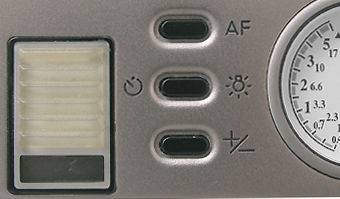 |
 You can also activate it manually by pressing the dual functions Self-timer/Illumination button (center button on the vertical row, on top panel). This illuminates both the viewfinder, the tiny top LCD panel as well as the analogue display scales. |
An additional built-in highlight of both the models was the standard databack. The Quartz Date function permits imprint of data in both the standard and Panorama formats. Size and position of the imprinted on the film are automatically adjusted even if you switch to other format (normal-panorama/panorama-normal). To use the data print/off function, select the desired display by pressing the MODE button while the camera is power OFF (actually the date and time adjustment for time clock also required to turn the camera's power off first). To adjust, make use of both the MODE (for altering format variations it rotates from: (Year/Month/Day; Month/Day/Year; Day/Month/Year or Day/Hour/Minutes and a imprint-OFF selection and back to the first format selection again) and the SET button is used to confirm each selection. Unlike other data backs, this feature also lets you keep accurate track of your picture-taking. This enables you to print data on the first picture of the day, or on the first picture of every roll-so you won't mix up your photographs.
Anything that I have missed ? Oh.. the Self Timer, the important battery power check as well as the unique Custom Function:-
To use self timer, while pressing the center dual purpose Self Timer/Illumination button (see above image) and turn the Command Dial clockwise. The film counter cum time exposure indicator on the analogue display will to the self timer clock symbol. When you fully depressed the shutter release button, the self timer indicator lamp will start blinking (approx. 8 seconds and then stays on for approx. 2 second and shutter will released. Nikon has designed a self timer that can be cancel even if you have activated it by just turn the selector dial to another position. If you have not started, press the Self timer button and use the command dial to switch to other frame number.
 |
Both the Nikon 35Ti & 28Ti Quartz Date models use a 3V lithium battery (DL123A or CR123A type) to power all its automatic functions. The battery cover has a rather weak design - although it was very secure once it is locked. I would rather a more comfortable attached design because once it was accidentally miss-placed or drop, I am not sure where are you going to get the replacement, so be careful. Battery status can be checked via the LCD panel, Insufficient power will has the battery indicator shown with an half-filled icon, if it blinks, it may be at its exhausted state. Actually, you can also feel the film advance speed as well as flash recharging will be considerably slower. |
Would you believe it ? Both
of these 1993/4N0ikon compact cameras were also designed with a Custom Function feature
to allow you to customized them to your personal preference. The following selection
of controls is possible with either the 35Ti or 28Ti Quartz Date's input button/command
dial control:
 |
* Auto flash mode: Select either Auto Flash or Flash Cancel (finder/analogue display illumination is also canceled). |
* Data imprint:- Data may be imprinted on all frames; or on the frame of the first shot of the day or the first shot of a roll.
* Analogue display reset:- Returning factory default settings or back to original positions.
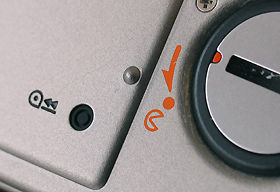 |
 |
Mid roll rewind is also possible with both cameras. There is a tiny button locates at the base of the camera. It is kind of hard to activate but it also serves as a precautional measure because not often one would perform this task. Use a pencil or sharp pin to push in and the film will rewind back to the cartridge regardless what number of frames has been used. The auto retractable lens cover is also made of titanium (when power off you can slide out the cover to examine the lense (but why would anyone want to do it ? so, it is just for reading reference only). |
Accessories included.
 |
Camera Case CS-L100 Soft leather case. Since the case is made of natural leather. the colour may fade Slightly if it gets wet or is robbed against something. Handle the case with care. Do not let it get wet, or the leather may shrink. If it becomes wet, wipe moisture off fully, reshape it and dry it in proper shape. For best results, periodically oil the case. |
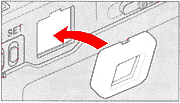 |
To see through the viewfinder more comfortably: If the viewfinder image is not crystal clear, try attaching the optional adapter. This changes the viewfinder from -1 diopter to +0.5 diopter. Confirm which is best for you, whether or riot you're using eye glasses, with or without the adapter. To detach the viewfinder eyepiece, insert a pointed object in the hole on top of the eyepiece and lift the eyepiece off. |
This website is not a review. It was created primarily to chronicle a remarkable photographic tool as well as supporting those who may be seeking a good, used condition Nikon compact camera for personal photography. So, I will skip unnecessary comparisons and directly in providing you ways to setup the camera and make the best out of it. However, choosing between the two excellent Nikon compacts can be a very hard decision. Personally, I love the elegant look of the champagne finish 35Ti but the 28mm wideangle that came with the 28Ti was more practical to use it for a wider range of applications (eventually, I bought both, and probably a year back or so, my Nikon 28Ti has "mysteriously" lost in my car - probably a car jockey somewhere has "borrowed" it..). Well, if ever Nikon has introduced a champagne chrome finish of the 28Ti QD version earlier, probably I will only settle for that model. What features did both missed in the basic specifications ? Not much. Perhaps an accessory shoe to assist the tiny, weak GN 8 (35Ti), GN 9 (28Ti).built-in speedlight. Both the speedlight were good enough for distance within 6-8 feet, beyond that working flash range, their weakness gengin to show. However, they are great for fill-in kind of use - such as for synchro-sunlight photography. Any others ? Not particularly important as the respective basic features found both of these two professional grade quality Nikon compact camera models are adequate enough in a hands of a thinking photographer & after all - it is more fun this way.
| Next | A simplified version of an Instruction Manual / Quick Guide to use the Nikon 35Ti or the Nikon 28Ti Quartz Date Compact Camera.
| Message Board | Questions or issues ? Use here for discussion
Other helpful pages relating to these two
NIkon compact camera models:
Nomencluture / Main reference
Map for Nikon 35Ti Quartz
Date | Nikon 28Ti Quartz Date
Technical Specification for both models
Notes on Panorama pictures - applicable for both models
| Back |
Main Index Page
|
Back | to Pictorial History of Nikon SLR /
rangefinder / Nikonos / digital cameras.
The Rangefinder
|| The
Nikonos ||
Compact Cameras
SLRs -1959/1979 |
1980/1990 | 1991/1999 | y2k/2003 | 2004 ~
The
Eyes of Nikon:-
Rangefinder
RF-Nikkor
lenses:-
Main Index Page | Nikon Manual Focus Nikkor lenses:- Main Index Page
Nikon
Auto
Focus
Nikkor lenses:- Main Index Page
![]()
Nikon F
| Nikon F2 |
Nikon F3 |
Nikon F4 |
Nikon F5 |
Nikon F6 |
Nikkormat / Nikomat |
Nikon FM
| Nikon FE/ FA | Nikon EM/FG/FG20 | Nikon Digital SLRs | Nikon - Other models
MIR Supports for Photographic Community: Various Message Boards/Community
Forums
Nikon
F-series|
Nikon
F2-series|
Nikon
F3-series|
Nikon F4-series| Nikon
F5-series|Nikkormat/Nikomat-series
Nikon FM-series|Nikon
FE-series|Nikon
FA|Nikon
Digital
SLR
series|Various
Nikon
Models|Nikkor
Optic
-shared
Others:- Free Trade Zone - Photography| Free Trade Zone - Business Community |Free To Zouk - Photographic Community
Apple's Mac Public Community Message Board | Windows based PC &
Apple/Mac
Public Community Trade Exchange Centre
Home - Photography In Malaysia
About this photographic site.
Copyright
© 1998. leofoo ®. MIR Web Development Team.

